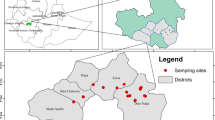Abstract
Due to water scarcity, storage and reuse of water has become a great challenge all over the world. The conventional methods for the wastewater treatment require large capital investment, operating cost, and need trained personal for supervision and maintenance. Therefore non conventional wastewater treatment methods have gained the popularity worldwide. Use of constructed wetland (CW) technology for wastewater treatment is highly efficient since CW are easy to construct, cost effective and increase the aesthetic value. Wetlands behavior and efficiency concerning wastewater treatment mainly depends upon macrophytes, substrate, hydrology, temperature and hydraulic retention time in the system. Present study deals with the removal of pollutants in two stage hybrid subsurface flow CW at different hydraulic retention times (HRT). The domestic wastewater was supplied to CW and treated using the available perennial macrophyte, Arundo donax. The system was run in replicate along with one control. To assess the removal efficiency of the pollutants, parameters like pH, temperature, dissolved oxygen (DO), total suspended solids (TSS), biological oxygen demand (BOD), chemical oxygen demand (COD) and total Kjeldahl nitrogen (TKN) were analyzed at different HRT i.e., 36, 30 and 24 h. The result of the study observed maximum percentage removal of TSS, BOD, COD, and TKN was up to 84.61, 98.37, 61.39 and 91.87% respectively at 30 h of retention time.


Similar content being viewed by others
REFERENCES
Alcamo, J.M., Vörösmarty, C.J., Naiman, R.J., Lettenmaier, D.P., and Pahl-Wostl, C., A grand challenge for freshwater research: Understanding the global water system, Environ. Res. Lett., 2008, vol. 3, no. 1, 010202.
Varis, O. and Somlyódy, L., Global urbanization and urban water: Can sustainability be afforded? Water Sci. Technol., 1997, vol. 35, no. 9, pp. 21–32.
Chand, R., Srivastava, S.K., and Singh, J., Changing Structure of Rural Economy of India Implications for Employment and Growth, Aayog: Natl. Inst. Transforming India, 2017. https://niti.gov.in/writereaddata/files/document_publication/Rural_Economy_DP_final.pdf.
Ávila, C., Salas, J.J., Martín, I., Aragón, C., and García, J., Integrated treatment of combined sewer wastewater and storm water in a hybrid constructed wetland system in southern Spain and its further reuse, Ecol. Eng., 2013, vol. 50, pp. 13–20.
Toet, S., van Logtestijn, R.S., Kampf, R., Schreijer, M., and Verhoeven, J.T., The effect of hydraulic retention time on the removal of pollutants from sewage treatment plant effluent in a surface-flow wetland system, Wetlands, 2005, vol. 25, no. 2, pp. 375–391.
Brix, H., Functions of macrophytes in constructed wetlands, Water Sci. Technol., 1994, vol. 29, no. 4, pp. 71–78.
Brix, H., Do macrophytes play a role in constructed treatment wetlands? Water Sci. Technol., 1997, vol. 35, no. 5, pp. 11–17.
Cooper, P., Griffin, P., Humphries, S., and Pound, A., Design of a hybrid reed bed system to achieve complete nitrification and denitrification of domestic sewage, Water Sci. Technol., 1999, vol. 40, no. 3, pp. 283–289.
Standard Methods for the Examination of Water and Wastewater, Washington, DC: Am. Publ. Health Assoc., 2005, pp. 258–259.
Verhoeven, J.T. and Meuleman, A.F., Wetlands for wastewater treatment: Opportunities and limitations, Ecol. Eng., 1999, vol. 2, nos. 1–2, pp. 5–12.
Kyambadde, J., Kansiime, F., and Dalhammar, G., Nitrogen and phosphorus removal in substrate-free pilot constructed wetlands with horizontal surface flow in Uganda, Water, Air, Soil Pollut., 2005, vol. 165, nos. 1–4, pp. 37–59.
CPCB, General standards for discharge of environmental pollutants, Part A: Effluents, 2019. http://www.cpcb.nic.in. Accessed June 11, 2020.
Vymazal, J., Horizontal sub-surface flow and hybrid constructed wetlands systems for wastewater treatment, Ecol. Eng., 2005, vol. 25, pp. 478–490.
Akratos, C.S. and Tsihrintzis, V.A., Effect of temperature, HRT, vegetation and porous media on removal efficiency of pilot-scale horizontal subsurface flow constructed wetlands, Ecol. Eng., 2007, vol. 29, no. 2, pp. 173–191.
Knight, R.L., Cooper, P., Brix, H., Vymazal, J., Haberl, R., and Kadlec, R.H., Constructed Wetlands for Pollution Control, London: Int. Water Assoc., 2000.
Kadlec, R.H. and Wallace, S.D., Introduction to Treatment Wetlands, Boca Raton, FL: CRC, 2009, 2nd ed., pp. 3–30.
Idris, S.M., Jones, P.L., Salzman, S.A., Croatto, G., and Allinson, G., Evaluation of the giant reed (Arundo donax) in horizontal subsurface flow wetlands for the treatment of dairy processing factory wastewater, Environ. Sci. Pollut. Res., 2012, vol. 19, no. 8, pp. 3525–3537.
Zhang, C.B., Liu, W.L., Wang, J., Ge, Y., Gu, B.H., and Chang, J., Effects of plant diversity and hydraulic retention time on pollutant removals in vertical flow constructed wetland mesocosms, Ecol. Eng., 2012, vol. 49, pp. 244–248.
Kadlec, R.H. and Knight, R.L., Treatment Wetlands, Boca Raton, FL: CRC, 1996.
Funding
Authors are extremely grateful to Guru Gobind Singh Indraprastha University, Dwarka, Delhi, India for providing financial support in successful completion of the research work.
Author information
Authors and Affiliations
Corresponding author
About this article
Cite this article
Neetu Rani, Karuna Narayan Pohekar Assessment of Hybrid Subsurface Flow Constructed Wetland Planted with Arundo Donax for the Treatment of Domestic Wastewater at Different Hydraulic Retention Time. J. Water Chem. Technol. 43, 178–183 (2021). https://doi.org/10.3103/S1063455X21020107
Received:
Revised:
Accepted:
Published:
Issue Date:
DOI: https://doi.org/10.3103/S1063455X21020107




